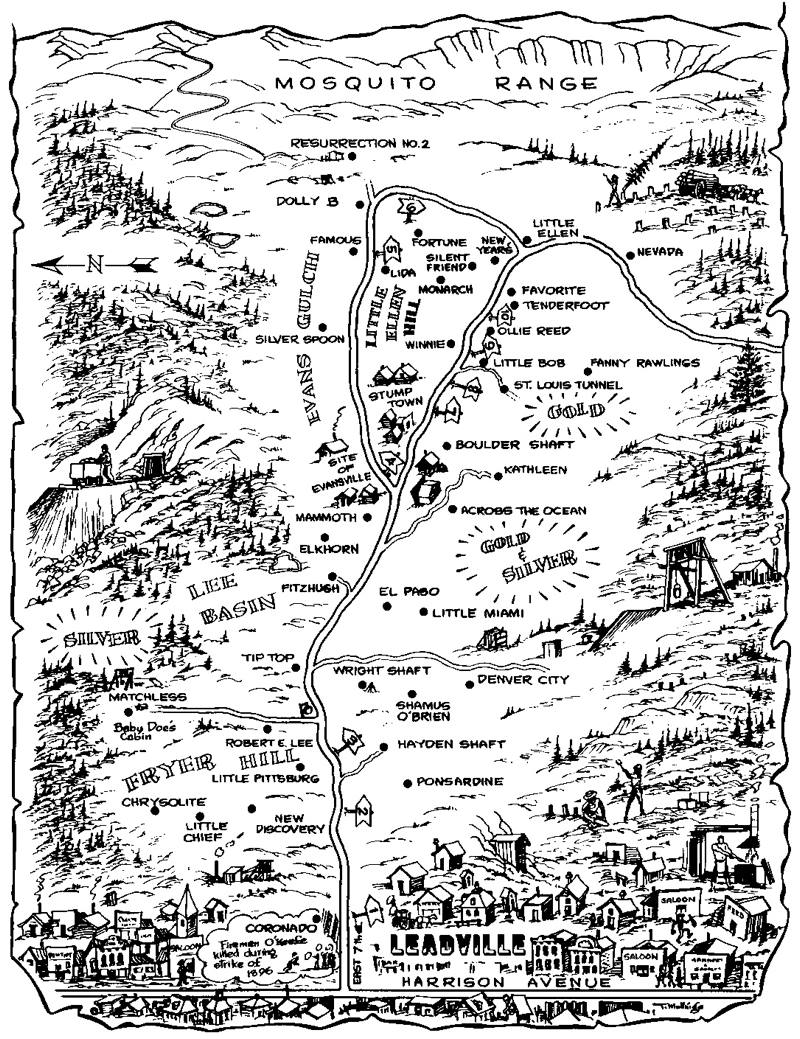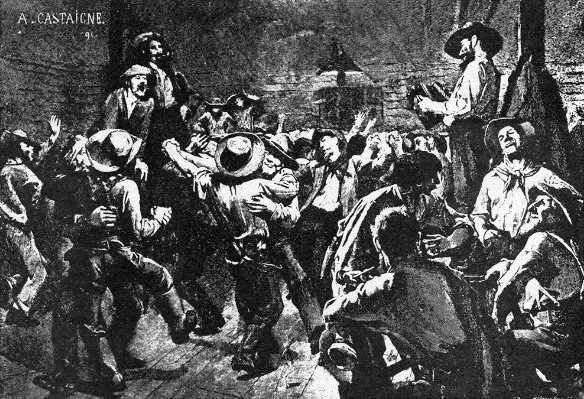
|
The Society of Folk Dance Historians (SFDH)
Boys' Night Out in Leadville
[
Home |
About |
Encyclopedia | CLICK AN IMAGE TO ENLARGE |

|
 Lonely, tired from long hours of backbreaking, often unrewarding labor, the vast, shifting male population at work in the silver and gold mines of the West vented its pent-up energies and frustrations in the dance halls, the hurdy-gurdy houses, saloons, and fandango houses in rowdy, bawdy brawling, dancing, singing, and carousing.
Lonely, tired from long hours of backbreaking, often unrewarding labor, the vast, shifting male population at work in the silver and gold mines of the West vented its pent-up energies and frustrations in the dance halls, the hurdy-gurdy houses, saloons, and fandango houses in rowdy, bawdy brawling, dancing, singing, and carousing.
Most Americans, especially those interested in folk dancing, become uneasy when the subject of American folk dances arises. They look at the wealth of customs and costumes, songs, and dances of other nations and feel somehow cheated and lacking.
American folk dance has always been difficult to identify. Many, perhaps even most, Americans say either that there is no real folk dancing in America, or that Square Dancing is American folk dance, period! (As a matter of fact, modern Square Dancing is a conscious effort to return to the values of the American's past and is largely an urban phenomenon.)
The difficulty in identifying American folk dancing comes from three basic reasons:
- We have never had a true peasantry, occupying a more or less contiguous territory, which performs special songs and dances and wears special costumes for calendrical occasions.
- The American population has always been mobile, preventing the establishment of the kinds of feudal societies congenial to the development of the folklore found in Asia, Europe, and Africa.
- We take a narrow view of what folk, or, more accurately, traditional dancing is.
We can challenge that limited outlook with a look at the Colorado mining camps of the late 19th century, where a rootless population with a wild imbalance of sexes created a special atmosphere and dance traditions that were indeed fascinating.
Lonely, tired from long hours of backbreaking, often unrewarding labor, the vast, shifting male population at work in the silver and gold mines of the West – especially Colorado, Nevada, California, and Alaska, plus the cattle towns of Wyoming, Texas, and Kansas – vented its pent-up energies and frustrations in the dance halls, the hurdy-gurdy houses, saloons and fandango houses in rowdy, bawdy, brawling, dancing, singing, and carousing.
In the earliest days of the mines, women were so few as to be a wonder. Men would come from miles around just to see one. From the outset, women were divided into two classes, good and bad, and for the first decades, the latter outnumbered the former. In fact, when the balance shifted, the more colorful aspects of the mining towns disappeared – at about the same time the mines themselves began to die, late in the 1880s.
 As a result of the scarcity of women, the men danced together, and in the partnered dances, one took the woman's part, generally being identified as such by tying a handkerchief on his arm, or even dancing within the frame of a hoopskirt.
As a result of the scarcity of women, the men danced together, and in the partnered dances, one took the woman's part, generally being identified as such by tying a handkerchief on his arm, or even dancing within the frame of a hoopskirt.
In the early days, one scholar reports, "the galop, the cross-eyed snap, the Irishman's trot, do-si-do, and schottische were among the favorite miners' dances." Other dances mentioned in the literature include the waltz, mazurka, jig, polka, and quadrille. "In Dawson, Alaska, the Oatley Sisters (Polly and Lottie) . . . danced the buck-and-wing in the Regina Saloon . . . For male support they would grab whatever prospector happened to pass by. These compliant amateurs ad-libbed with considerable profanity, suiting the taste of those present." And in the 1870s, the Colorado Miner described the hurdy-gurdy houses of Leadville as "breathing holes of hell, where customers imbibe torchlight whiskey and indulge in the quadrille and the whirling sinuosities of the waltz."
It is clear from the many lithographs and illustrations of the period that dancing in these saloons and dance halls was no sedate occupation. "Dora Hand, a supposedly ex-Beacon Hill blueblood, loved to dance the fandango on tables, bar counters, and grand pianos ...(Her) 'Home, Sweet Home', sung in a rich alto, made hardened barfrogs and muleskinners weep." In Billings, Montana, "a puncher and a waitress took first prize for dancing the Bull Calf's Medley on the piano at a gala Saturday night hoedown."
In the first years after the California gold rush of 1848, the first saloons and dance halls of the West were tents or primitive cabins with pounded dirt floors, but quick prosperity soon created a range of styles and degrees of elegance, so that by the late 1870s and early 1880s, establishments of luxury and opulence vied for the attention – and the money – of the miners.
The lure of money and gold soon brought the amenities of civilization, meaning more available women, drugs, gaming, and entertainment. The mining and trail towns of the West, such as Leadville, Cripple Creek, Deadwood, Tombstone, and Abilene, soon earned unsavory reputations as sinks of depravity, and while they probably could not compare to the contemporary urban scene, they were truly wild by 19th century standards. Large mobile populations, free of the restraints of family, anonymous, with no reputations to protect, created an environment of violent death, unbridled morals, and general rowdiness to match. Many of the dance hall girls as well as the men fell prey to death in the violent gunfights, venereal disease, and the widespread use of such narcotics as opium and laudanum.
"Fights in Leadville kept life from being monotonous," a local historian wrote. "Misunderstandings ended in knifings, shootings, and free-for-alls. Men fought on the streets, in saloons, in dance halls, in hotels, at the theatres."
By most accounts, the earliest dance hall girls were considered good girls, at least by Western standards. The very first women in the mining camps of California were German girls who were called hurdy-gurdy girls after the musical instruments of the same name, and the name also became attached to the dance hall. While a long way from virginal status, the first girls were so prized that they did not have to participate in prostitution. Because they were so few, women in the early dance halls were expected to follow a respectable code of behavior and men were expected to keep their distance. One old miner recalled seeing a sign in a hurdy-gurdy house: "A SKIRT IS A SKIRT AND MUST BE RESPECTED AS SUCH!" The owner of the Alhambra, a hall in Silverton, Colorado, posted the following set of rules:
Rule 1. No lady will leave the house during evening working hours without permission.
Rule 2. No lady will accompany a gentleman to his lodgings.
Rule 3. No kicking at the orchestra, especially from the stage.
Rule 4. Every lady will be required to dance on the floor after the show.
Rule 5. No fighting or quarrelling will be allowed.
As competition grew rapidly, the fine line between prostitution and the dance hall thinned, blurred, and finally disappeared. In some of the establishments, there were rooms upstairs, cribs behind the hall, or curtained booths and private stalls in the balconies where one could sample the wares.
"The short-skirted, painted dance hall girls earned good sums every night," one account says, "but they envied 'the ladies' in the parlor houses with their magnificent dresses and diamonds. As the latter came into the dance halls or gambling houses, as they strolled down the streets or rode in their handsome carriages, they caused many a girl to try to join the scarlet sisterhood."
In Leadville, with more than 150 dancing and gaming establishments in business, competition for customers became keen. In Cripple Creek, the halls "all had eight- and ten-piece bands, lots of dance hall girls, and racy burlesque shows. Before each performance, the management of the theatre sent the band and show girls out to parade up and down the street to drum up interest – this was how the song 'There'll be a Hot Time in the Old Town Tonight' became popular."
Some of the women sported colorful names such as Snake Hips Lulu, Leo the Lion, Scarface Liz, Liverlip, Cowboy Annie, Diamond Tooth Lil, Big-Nose Kate, Lost Chicken, Rockin' Chair Emmy, Virgin Mary, Hop-Fiend Kitty, Jack-Rabbit Sue, and Razorback Jennie. They wore a variety of garb, some imaginative, some even demure. Though they wore short skirts, they did not dress like Kitty in "Gunsmoke." They had much more decolletage, but the legs were covered so that little or no flesh showed. One chronicler reports, "Throughout the West, young and not-so-young ladies danced the Cancan or its variation, the Clodoche, to the sound of wheezing melodeons, giving delighted miners and cowhands tantalizing glimpses of rustling froufrou, froth of dessous, batiste bloomers, elaborate garters and, above them, two fingers of white, real flesh." The woman often wore heavy footgear to protect her from the cold and the heavy-footed exuberance of her partners, for she frequently danced as many as 50 dances a night.
Many of the girls were probably not much to look at by today's standards, since the majority were escaping from the poverty of Eastern tenements or Midwestern sodbusters' hovels, but others, from their photographs, were exceedingly beautiful and made good money, some as much as $100 a night – at a time when a dollar purchased a lot.
One contemporary source, Thomas J. Dimsdale, had this to say about the girls in the dance halls: "Let us describe a first-class dancer – 'sure of a partner every time'. There she stands at the head of the set. She is of middle height, of rather full and rounded form; her complexion is as pure as alabaster, a pair of dangerous-looking hazel eyes, a slightly Roman nose, a small and prettily formed mouth. Her auburn hair is neatly banded and gathered in a tasteful, ornamented net, with a roll and gold tassels at the side. How sedate she looks dancing the first figure, never smiling until the termination of the 'promenade eight', when she shows her little white hands in fixing her handsome brooch in place and settling her glistening earrings. See how nicely her scarlet dress with its black edgings sets off her dainty figure. No wonder that a wild mountaineer would be willing to pay – not one dollar, but all that he has in his purse."
Lest one think that the men of the West were exposed only to the Cancan for entertainment, it should be noted that the range of entertainment and culture in these saloons and concert theatres ranged from the ridiculous to the slime. Tombstone featured a belly dancer in a harem outfit of baggy pants and a vest, while other, more enterprising owners featured bottomless "pretty girl waiters." The Carbonate Concert Hall in leadville featured everything from Pinafore to the lady Vienna Orchestra. Its featured artists were Mollie Newton, "the finest formed woman in America," and Belle lamont, "celebrated song and dance artiste." Mollie Newton's specialty was "a series of beautiful tableaux representing Greek and Roman statuary." In addition, Shakespearean plays, several Gilbert and Sullivan grand operas, melodramas, serious plays, and even some highly popular lectures by Oscar Wilde were available fare for the miners. One must realize that some of the towns, such as Leadville, sported opera houses and theatres that could accommodate these productions and would have been at home in an Eastern city or in Europe.
Richard Erdoes, author of Saloons of the Old West, has reconstructed a typical evening in a dance hall which is worth quoting in length because it so well captures the flavor of the time:
"By eight o'clock, the dance hall filled with clumsily booted miners, cowboys, or railroadmen, depending upon the locality. The girls were waiting, sitting demurely on their chairs, the musicians at their stations, the faro dealers alert, the bar ready . . .
"After the boys had had their hair of the dog and paid the ante for the first go-round, the fiddler called out: 'Gents, take your partners for a dance!' and scraped away on his violin while the Professor (the piano player) pounded out a varsouvienne or a waltz, a mazurka or a schottische . . . At the end of the allotted time – anywhere from five to fifteen minutes, depending on the house policy – the dance ended with a suddenness which left some dancers stumbling.
"The fiddler called out, 'Gents, balance your partners up to the bar!' The girls immediately and deftly steered their partners to the counter, where the men obediently bought them drinks. While the boys downed their whiskey, the girls took a nip of the colored sugar water. They had to remain sober, because a tipsy girl on the dance floor was a calamity. As they said in cow country: 'A hurdy gal on a drunk raises more hell than a locoweed-fed bull.'
"In some places, a patron, after buying a girl 'five fancy drinks', received 'one snake free and likewise a hop-and-skip ticket'. After the treats had been speedily consumed, the bardog rapped the counter with his bung starter as a sign for the girls to 'weigh out' – that is, to sit down for a minute to 'get their steam up' – after which the dancing started all over again. A popular girl averaged 50 dances, no mean feat of endurance considering the vigorous stomping and whirling of cowboys and miners intent on getting their money's worth. At a buck a dance, this netted a girl $25 – her half share of the tickets initialed by her – plus her commission on drinks she had induced her partners to buy, and that was no mean sum, either – ample reward for the strain on her ankles.
"In the Alaskan gold rush camps, the hurdy houses had balconies. There the affluent prospector could sit and watch. It was the custom for a well-heeled miner to pick out a girl of his choice and shower her with gold dust, most of which was caught in her hairdo – usually an elaborate one during the Gay Nineties. A shampoo usually yielded a girl from $10 to $20. Miners also pitched pea-sized gold nuggets into the hurdy girls' cleavages, enjoying the spectacle of seeing the young ladies trap the shining kernels between their ample bosoms . . . Finally, the fiddler called out: 'One last dance, gentlemen', followed by 'Only this one more afore the gals go home', and that ended the long, long night."
The author is grateful to the Leadville Historical Society for providing dance programs, theatre bills, and other memorabilia of the period.
NOTE: The square dance was adopted as the Colorado official state folk dance on March 16, 1992, by an act of the General Assembly. "Square dancing is the American folk dance which traces its ancestry to the English country dance and the French ballroom dance, and which is called, cued, or prompted to the dancers. Square dance includes squares, rounds, clogging, contra, line, the Virginia Reel, and heritage dances." Citation: House Bill 1058, 1992; Colorado Revised Statute 24-80-909.5.
DOCUMENTS
- Anthony Shay, an article.
- Dance in the Old West, an article.
- Gold Miners Dances, an article.
Used with permission of the author.
Condensed from an article in Folk Dance Scene, May, 1980.
This page © 2018 by Ron Houston.
Please do not copy any part of this page without including this copyright notice.
Please do not copy small portions out of context.
Please do not copy large portions without permission from Ron Houston.